Project Categories: Main Beam TBM
Meråker
Descripción del proyecto
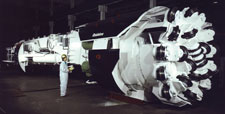 El proyecto de Meråker consiste en un conjunto de centrales eléctricas y túneles para incrementar la producción eléctrica que da servicio tanto a la población de la zona como a una fundición local. Los 44 km de túnel se alimentan del agua de tres lagos y varios ríos y la transportan hasta una planta de generación en Tevla. Desde ahí, el agua viaja a través de tuberías de presión hasta la central hidroeléctrica de Meråker.
El proyecto de Meråker consiste en un conjunto de centrales eléctricas y túneles para incrementar la producción eléctrica que da servicio tanto a la población de la zona como a una fundición local. Los 44 km de túnel se alimentan del agua de tres lagos y varios ríos y la transportan hasta una planta de generación en Tevla. Desde ahí, el agua viaja a través de tuberías de presión hasta la central hidroeléctrica de Meråker.
Merkraft, una agrupación de Eeg Henriksem Anlegg a/s y a/s Veidekke, escogió utilizar una tuneladora abierta Robbins de 3,5 m de diámetro para perforar el túnel de Meråker, de 10 km de longitud. El resto de túneles se excavó mediante perforación y voladuras.
Geología
La roca que el túnel atravesó estaba compuesta de sedimentos cámbricos y ordovícicos con intrusiones de meta gabro. Se distinguieron seis tipos diferentes de roca a lo largo de la traza del túnel, incluyendo desde filitas relativamente blandas hasta meta gabro muy duro, pasando por frentes mixtos de grauvacas y areniscas.
TBM
Robbins construyó la tuneladora abierta para perforar con éxito la variedad de roca del macizo. La máquina iba equipada con cuatro motores de 335 kW cada uno y de 25 cortadores de 19” de montaje delantero. La potencia en cabeza de corte era de 1340 kW, proporcionando un empuje de 10291 kN.
Esta tuneladora de muy alta potencia se construyó mecánicamente de un modo mucho más robusto que sus predecesoras, garantizando una mucho mayor durabilidad del equipo. La máquina representó una de las primeras de una nueva línea de producción de Robbins de tuneladoras capaces de soportar esfuerzos mucho mayores que los habituales. Estas TBMs representaron el comienzo de una nueva generación de tuneladoras equipadas con rodamientos principales triaxiales y cabezas de corte de diseño especializado en mejorar la eficacia de la perforación a empujes muy altos.
Excavación del túnel
La TBM comenzó a perforar en septiembre de 1991 alcanzando en seguida unos índices de avance impresionantes. En su primer mes complete de trabajo la máquina perforó 1029 m de túnel. Poco después, en la semana del 28 de noviembre al 3 de octubre, la máquina estableció un nuevo récord noruego de perforación al totalizar 395 m de avance. Durante la perforación del túnel se alcanzaron índices de penetración de hasta 10 m/h, siendo la media de los mismos de 6 m/h. El avance medio semanal fue de 253 m, el mejor día de perforación se excavaron 100 m de túnel; en su mejor semana, la máquina perforó 427 m y en su mejor mes, 1358 m. Todos estos resultados tan sobresalientes se obtuvieron con dentro de las restricciones normativas noruegas para trabajos subterráneos.
La máquina finalizó los 10 km de túnel en 1992 con un Adelanto de seis meses con respecto a lo programado. Esta anticipación hizo que el resto del complejo de 44 km de túnel se completase a finales de 1992.
Chicago's Tunnel and Reservoir Plan (TARP)
Thirty TBMs participate in Chicago’s Epic Tunnel and Reservoir Plan (TARP)
Project Description
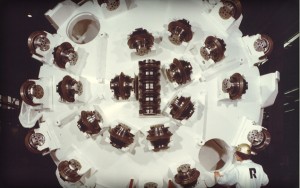 Spanning 20 years and using over 30 TBMs, Chicago’s massive Tunnel and Reservoir Plan (TARP) has been possibly the largest clean water project of the twentieth century. The TARP was created in 1975 to combat increased flooding and drainage problems that plagued Chicago and surrounding areas. After heavy rains, combined sewage overflows (CSOs) would seep into residential basements, nearby streams and rivers, as well as Lake Michigan – Chicago’s main source for drinking water. TARP was originally divided into two phases but now refers solely to Phase I.
Spanning 20 years and using over 30 TBMs, Chicago’s massive Tunnel and Reservoir Plan (TARP) has been possibly the largest clean water project of the twentieth century. The TARP was created in 1975 to combat increased flooding and drainage problems that plagued Chicago and surrounding areas. After heavy rains, combined sewage overflows (CSOs) would seep into residential basements, nearby streams and rivers, as well as Lake Michigan – Chicago’s main source for drinking water. TARP was originally divided into two phases but now refers solely to Phase I.
Phase I
Phase I was directed towards pollution control and consisted of tunnels, drop shafts, and dewatering stations to eliminate nearly 85 percent of CSO pollution. Four tunnel systems comprise the first phase: Mainstream, Des Plaines, Calumet and O’Hare, which have a combined length of 176.1 km (109.4 mi) and range in diameter from 2.4 m to 10.8 m (8.0 ft to 35.4 ft). Nearly all of the tunnels were excavated in the area’s dolomitic limestone, and required the use of TBMs up to 10.8 m in diameter—the largest TBMs that had ever been built at the time.
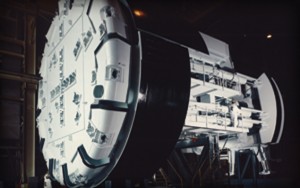 The Mainstream Tunnel System was composed of 65.2 km (40.5 mi) of tunnel, the Des Plaines System with 41.2 km (25.6 mi), the O’Hare System with 10.6 km (6.6 mi), and the Calumet System of 59.1 km (36.7 mi). A later tunnel for the Little Calumet Leg of the Calumet system was excavated using a Robbins TBM in 2002, setting multiple records in the process including 138 m (452 ft) bored in one day. Immediately upon completion, each tunnel system was put into service and the benefits were seen almost instantaneously. After more than 30 years and over 160 km (100 mi) of tunnels, the entire first phase of the TARP system became operational in 2005.
The Mainstream Tunnel System was composed of 65.2 km (40.5 mi) of tunnel, the Des Plaines System with 41.2 km (25.6 mi), the O’Hare System with 10.6 km (6.6 mi), and the Calumet System of 59.1 km (36.7 mi). A later tunnel for the Little Calumet Leg of the Calumet system was excavated using a Robbins TBM in 2002, setting multiple records in the process including 138 m (452 ft) bored in one day. Immediately upon completion, each tunnel system was put into service and the benefits were seen almost instantaneously. After more than 30 years and over 160 km (100 mi) of tunnels, the entire first phase of the TARP system became operational in 2005.
Phase II
Phase II, now called the Chicago Underflow Plan (CUP), consists of three main reservoirs: the Majewski Reservoir, Thornton Reservoir, and McCook Reservoir with a combined capacity of 69.05 billion liters (18.24 billion gallons). The reservoirs are a joint project of the Water Reclamation District and the U.S. Army Corps of Engineers, built to provide flood relief by storing the water collected and transferred from the TARP tunnels until it can be treated at local reclamation plants.
Excavation and Breakthrough
Construction on the Majewski CUP Reservoir was started in 1990 and finished in 1998, with a capacity of 1.29 billion liters (342 million gallons). The Thornton Reservoir was divided into two stages, including a transitional reservoir completed in 2003, and a permanent CUP reservoir completed in 2015. The permanent CUP reservoir has a capacity of 29.9 billion liters (7.9 billion gallons) and provides an estimated $40 million annually to 15 communities. Finally, the McCook Reservoir, also planned as a two-stage build, will provide storage of up to 38 billion liters (10 billion gallons). The first stage was completed in 2017, while the completion date of the second stage is scheduled for 2029. To date, the reservoirs have yielded hundreds of millions of dollars in flood damage reduction benefits.
The TARP program has won numerous awards and honors over the years from the local and federal EPA, as well as the American Society of Civil Engineers award in 1986 for the most outstanding civil engineering project. The tunnels and reservoirs have resulted in a dramatic improvement to water quality in Lake Michigan, and have eliminated CSO overflows. Fish and wildlife have returned in recent years to local rivers and to Lake Michigan, and the waterfront property is becoming more attractive to businesses and the general population alike.
Pahang Selangor Raw Water Tunnel
Trio of TBMs bore Malaysia’s Largest Infrastructure Project
Project Overview
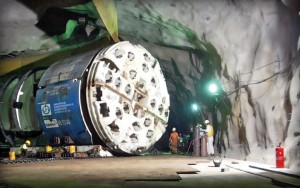 The Pahang Selangor Raw Water Tunnel, for the Malaysian Ministry of Energy, Green Technology, and Water, conveys raw water from the Semantan River in Pahang to the South Klang Valley area of Selangor state. The three tunnels, totaling 44.6 km (27.7 mi), address projected water shortages due to the area’s rapidly growing population. The tunnel transfers 27.6 cubic meters (7,300 gallons) of water per second to a new treatment plant. The drinking water supplies about 7.2 million people.
The Pahang Selangor Raw Water Tunnel, for the Malaysian Ministry of Energy, Green Technology, and Water, conveys raw water from the Semantan River in Pahang to the South Klang Valley area of Selangor state. The three tunnels, totaling 44.6 km (27.7 mi), address projected water shortages due to the area’s rapidly growing population. The tunnel transfers 27.6 cubic meters (7,300 gallons) of water per second to a new treatment plant. The drinking water supplies about 7.2 million people.
The SNUI JV, consisting of Shimizu Corporation, Nishimatsu Construction, UEM Builders Bhd, and IJM Construction, chose three Robbins 5.23 m (17.2 ft) diameter Main Beam TBMs to excavate the three sections of the tunnel. The total supply included back-up systems, continuous conveyors, cutters, spares, and field service personnel.
Ground Support and TBM Design
Tunneling took place in high cover conditions, up to 1,200 m (3,900 ft) below the Titiwangsa mountain range. Geology during the initial stages of advance consisted of hard, abrasive granitic rock up to 200 Mpa (29,000 psi) UCS. The tunnels were supported with ring beams, rock bolts, and shotcrete depending on the conditions. If unstable ground was encountered, invert thrust systems could be utilized to avoid gripping against the tunnel walls.
To successfully excavate the hard rock, each High Performance (HP) TBM was fitted with 19-inch (482 mm) back-loading disc cutters- making them the smallest diameter back-loading cutterheads ever provided. The cutters were carefully monitored for wear using remote monitoring systems. The wireless systems allowed the crew to plan cutter changes and keep track of wear by recording several variables on each cutter, including cutter rotation (which is computed to percentage wear), temperature, and vibration. Each 19-inch face and gage cutter was equipped with a sensor bolted inside the cutter housing, allowing raw data to be sent to a program display in the operator’s cabin.
Tunnel Excavation
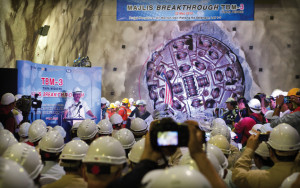 The first machine was launched on November 10, 2010, followed shortly after by the second on December 30, 2010. The third machine began boring in March 2011 and all three machines are currently boring as scheduled. All of the machines were assembled outside their particular adits, then “walked” down a 6-10% grade to an NATM-excavated starter tunnel. Two of the machines were launched with a shortened back-up configuration of 10 decks and a temporary transfer conveyor, while the third for logistical reasons utilized trucks for muck removal in the preliminary boring phase. Once the machines had advanced about 100 m (330 ft), the remaining back-up decks and permanent Robbins continuous conveyor were then installed, due to the adit configurations.
The first machine was launched on November 10, 2010, followed shortly after by the second on December 30, 2010. The third machine began boring in March 2011 and all three machines are currently boring as scheduled. All of the machines were assembled outside their particular adits, then “walked” down a 6-10% grade to an NATM-excavated starter tunnel. Two of the machines were launched with a shortened back-up configuration of 10 decks and a temporary transfer conveyor, while the third for logistical reasons utilized trucks for muck removal in the preliminary boring phase. Once the machines had advanced about 100 m (330 ft), the remaining back-up decks and permanent Robbins continuous conveyor were then installed, due to the adit configurations.
During the initial stages of advance, the machines achieved rates of up to 3.5 m (11.5 ft) per hour, leading the three machines to excavate over 1,400m (4,600 ft), 540 m (1,800 ft) and 330 m (1,100 ft), respectively by April 2011. As each TBM continued on its 11km (6.8 mi) run, the machinery had to overcome adversity including blocky rock, over-break, power outages and water inflows.
The machines maintained excellent advance rates throughout the project despite many challenges. Due to the hot springs the machines were boring under, water ingress at temperatures up to 56 degrees Celsius was recorded. Maximum rates of 49 m in one day, 198 m in one week, and 657 m in one month were nonetheless achieved.
Among other methods of ground support used during boring, the near-zero rebound fiber mortar (sprayed shotcrete) is the primary method being used during the Pahang Selangor Project. This marks the first time this method has been used outside of Japan. The success of this innovative implementation has been proven through reduced project downtime, dust reduction and good bonding.
Breakthrough
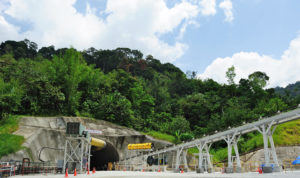 The first of three 5.23 m (17.2 ft) Main Beam Robbins TBMs broke through at the Pahang Selangor Raw Water Tunnel on March 22, 2013 to a large ceremony of cheering onlookers. The breakthrough was attended by dignitaries, contractors and honored guests, with everyone very enthusiastic about the machine’s success.
The first of three 5.23 m (17.2 ft) Main Beam Robbins TBMs broke through at the Pahang Selangor Raw Water Tunnel on March 22, 2013 to a large ceremony of cheering onlookers. The breakthrough was attended by dignitaries, contractors and honored guests, with everyone very enthusiastic about the machine’s success.
The two remaining 5.23 m (17.2 ft) machines met in the middle of the tunnel in mid-February 2014. It was a moment worthy of celebration; marking the completion of the longest tunnel in Southeast Asia.
- Twin Robbins EPBs make milestones near Taj Mahal
- Long Haul TBM: Use of a Rebuilt Main Beam Machine at the DigIndy Tunnel System in Indianapolis, IN
- Evaluating TBM Design and Performance, 30 Years Apart: The Lesotho Highlands Water Tunnel, Phase 1 and Phase 2
- Overcoming Mountainous Geology at Nepal's Sunkoshi Marin Project
- Swift Robbins TBM breaks through 11 Months Early

 Close
Close  Menu
Menu 